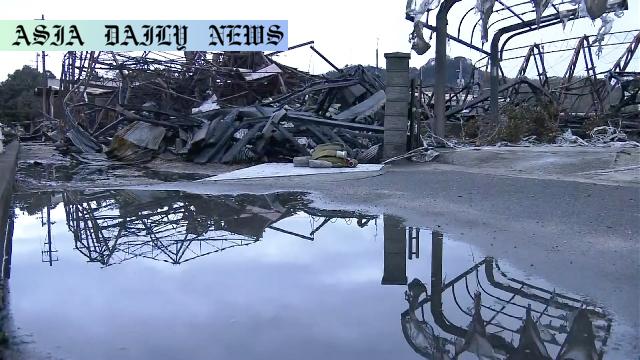Wildfires: Rain has eased forest fires in Imabari City, creating moist conditions, yet aerial surveys reveal remaining heat sources.
Imabari City sees relief from forest fires due to rainfall.
442 hectares were damaged, 21 structures affected by the fires.
Nearly 6,000 people received evacuation orders in Imabari City.

Overview of Wildfires in Imabari City
In recent days, Imabari City, situated in the western Japanese prefecture of Ehime, has endured devastating forest fires that scorched approximately 442 hectares of land, causing significant damage to residential and agricultural resources. However, a ray of hope emerged as the first rainfall since the fires started was recorded, providing some much-needed relief for firefighters battling the blazes. Reports noted puddles forming on roads near the impacted areas, with the smoldering odors beginning to subside.
Impact of the Rainfall
The rainfall, joined by moist winds, played a pivotal role in alleviating the spread of the flames. Nevertheless, extinguishing the fires completely remains an ongoing task. Drone surveys conducted by authorities identified multiple heat sources within the affected zones, signaling that the risk of rekindling is not yet eliminated. Despite this, the rainfall has provided essential moisture to the dry, fire-prone conditions that fueled the destruction over the past week.
Structural and Societal Damage
The wildfires have left a trail of destruction across Imabari City, damaging a total of 21 structures, including houses and warehouses, and displacing numerous families. Approximately 6,000 citizens were subjected to evacuation orders to safeguard their lives and properties. Temporary shelters are currently accommodating those who have fled their homes, with neighboring Saijo City also enacting similar evacuation measures for some areas in the vicinity. Immediate relief efforts and rebuilding strategies are now a top priority for local government and disaster response teams.
Coordinated Disaster Response
Imabari Mayor Tokunaga Shigeki, addressing the city’s disaster response meeting, expressed cautious optimism about the containment of the fires. While the immediate threat has been mitigated, the focus has shifted to comprehensive recovery efforts and ensuring that any residual heat pockets in wildfire-damaged areas do not reignite. Local communities have rallied together to support the victims and assist the emergency response crews who have worked tirelessly to suppress the fires under challenging conditions.
The Path to Recovery
Looking ahead, Imabari faces substantial recovery and rebuilding challenges. With 442 hectares of land scarred by the fires and livelihoods disrupted, concerted efforts from the government, citizens, and international aid organizations are required to restore normalcy. Rehabilitation of the affected areas will also involve reforestation and environmental restoration measures to prevent similar disasters in the future. Efforts to address the root causes of such wildfires, including climate change and land management practices, will be essential for long-term solutions.
A Broader Perspective on Wildfires
Globally, wildfires are becoming increasingly common and devastating, primarily due to changing climate conditions and rising temperatures. The Imabari incident underlines the critical need for proactive measures in forest fire management and disaster preparedness. Modern technologies like drone surveys and early warning systems have proven invaluable in this endeavor, but the role of community education and awareness in mitigating disaster risks cannot be overlooked. By learning from this tragedy, Imabari and other regions worldwide can equip themselves better to handle future challenges posed by natural disasters.
Commentary
Reflecting on the Wildfires in Imabari
The recent wildfires in Imabari City are a stark reminder of the increasing frequency of natural disasters driven by global climate challenges. This devastating event, which has destroyed hundreds of hectares and displaced thousands, showcases both the fragility of our ecosystems and the resilience of community efforts in overcoming such adversities.
The Role of Rainfall as a Natural Ally
Rainfall brought a glimmer of hope to Imabari City, suppressing flames and providing reprieve for firefighters and residents alike. However, it also highlights the complexities of relying on natural circumstances to combat emergencies. The sporadic nature of such assistance underscores the necessity for stronger disaster preparedness frameworks. The use of drones to detect residual heat gives a valuable technological edge in managing such situations, setting an example for other disaster-prone areas worldwide.
Community Spirit in the Face of Tragedy
As we look at the impact on Imabari’s 6,000 evacuees, who have shown great resilience in the face of adversity, the importance of community solidarity becomes evident. It is heartening to see neighboring Saijo City stepping in with shelters and support for the displaced. Collaborations such as these are crucial for providing emotional and logistical aid during such testing times and serve as a reminder of the strength found in unity.
The Larger Climate Picture
Imabari’s wildfires are a small yet significant chapter in the broader narrative of climate change’s impact on our world. The dry conditions that likely contributed to the fire’s spread serve as a wake-up call for governments and citizens globally to take actionable steps in mitigating climate risks. As we work towards recovery in Imabari, let this tragedy serve as, not just a cautionary tale, but also as an impetus for lasting change to prevent future disasters of this scale.


